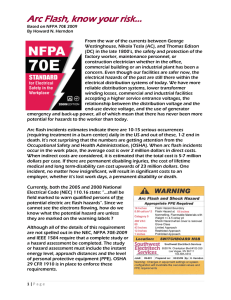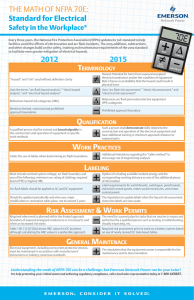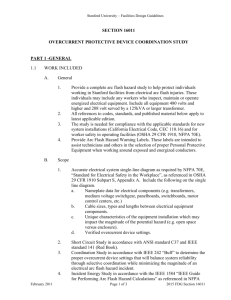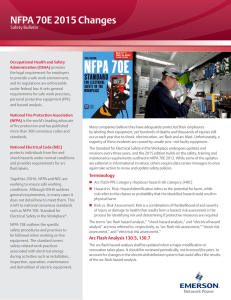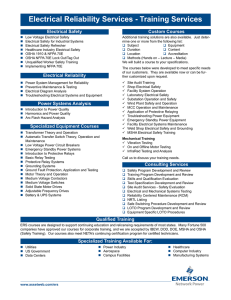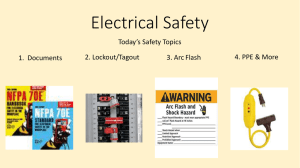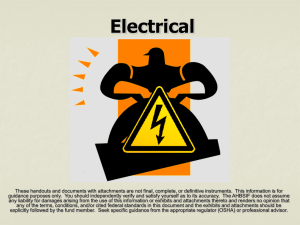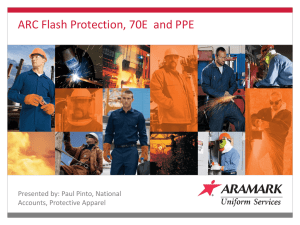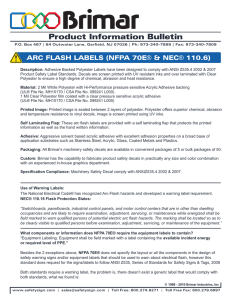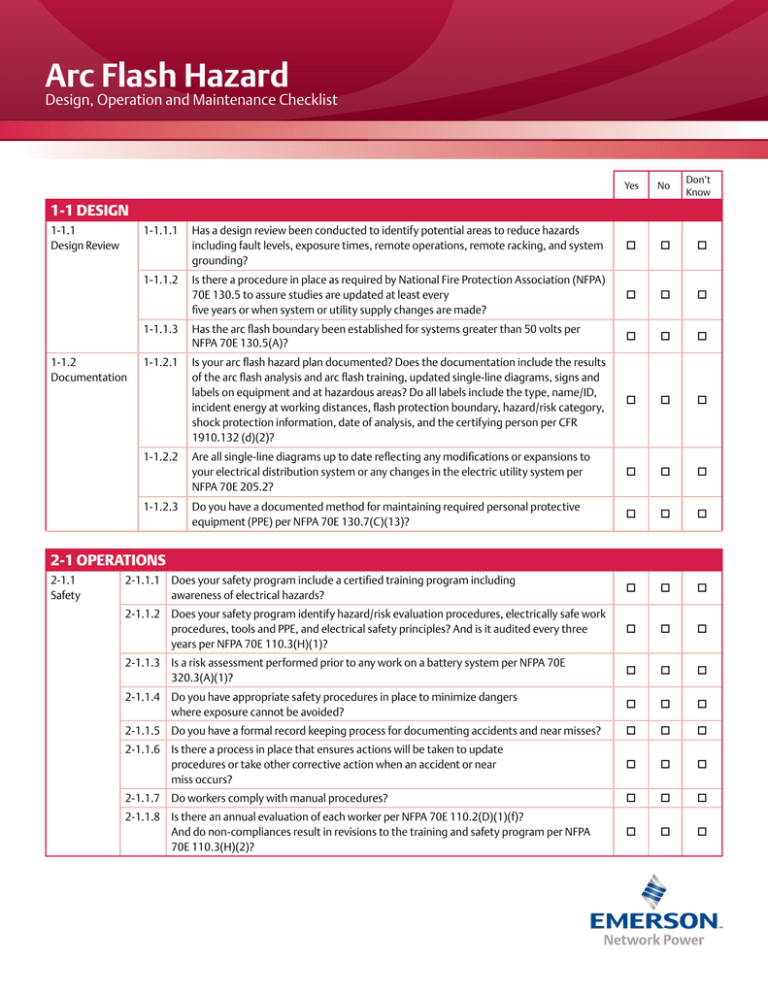
Arc Flash Hazard
Design, Operation and Maintenance Checklist
Don’t
Know
Yes
No
Has a design review been conducted to identify potential areas to reduce hazards
including fault levels, exposure times, remote operations, remote racking, and system
grounding?
Is there a procedure in place as required by National Fire Protection Association (NFPA)
70E 130.5 to assure studies are updated at least every
five years or when system or utility supply changes are made?
1-1.1.3
Has the arc flash boundary been established for systems greater than 50 volts per
NFPA 70E 130.5(A)?
1-1.2.1
Is your arc flash hazard plan documented? Does the documentation include the results
of the arc flash analysis and arc flash training, updated single-line diagrams, signs and
labels on equipment and at hazardous areas? Do all labels include the type, name/ID,
incident energy at working distances, flash protection boundary, hazard/risk category,
shock protection information, date of analysis, and the certifying person per CFR
1910.132 (d)(2)?
Are all single-line diagrams up to date reflecting any modifications or expansions to
your electrical distribution system or any changes in the electric utility system per
NFPA 70E 205.2?
Do you have a documented method for maintaining required personal protective
equipment (PPE) per NFPA 70E 130.7(C)(13)?
2-1.1.1 Does your safety program include a certified training program including
awareness of electrical hazards?
2-1.1.2 Does your safety program identify hazard/risk evaluation procedures, electrically safe work
procedures, tools and PPE, and electrical safety principles? And is it audited every three
years per NFPA 70E 110.3(H)(1)?
2-1.1.3 Is a risk assessment performed prior to any work on a battery system per NFPA 70E
320.3(A)(1)?
2-1.1.4 Do you have appropriate safety procedures in place to minimize dangers
where exposure cannot be avoided?
2-1.1.5 Do you have a formal record keeping process for documenting accidents and near misses?
2-1.1.6 Is there a process in place that ensures actions will be taken to update
procedures or take other corrective action when an accident or near
miss occurs?
2-1.1.7 Do workers comply with manual procedures?
2-1.1.8 Is there an annual evaluation of each worker per NFPA 70E 110.2(D)(1)(f)?
And do non-compliances result in revisions to the training and safety program per NFPA
70E 110.3(H)(2)?
1-1 DESIGN
1-1.1
Design Review
1-1.1.1
1-1.1.2
1-1.2
Documentation
1-1.2.2
1-1.2.3
2-1 OPERATIONS
2-1.1
Safety
Arc Flash Hazard
Design, Operation and Maintenance Checklist
Don’t
Know
Yes
No
2-1.2.1 Do you have an effective arc flash training program that adheres to OSHA regulations
1910.132(f)? Does it provide workers the knowledge and understanding of the existence,
nature, causes, and methods to prevent electrical hazards?
2-1.2.2 Does your arc flash training program include training on arc flash awareness, standards and
codes, understanding of arc flash quantities, selection and use of appropriate PPE, reading
and following warning signs and labels, methods to reduce risk while working on live
exposed parts, and arc flash hazard assessment?
2-1.2.3 Is there a process in place that ensures the training program is periodically reviewed to
identify needed changes?
2-1.2.4 Have all personnel working on or near energized equipment undergone specific training
in the hazards of working on energized equipment, and the use and proper application of
PPE?
2-1.2.5 Do training records exist?
2-1.3
Labeling
2-1.3.1 Does all electrical equipment that may remain energized during maintenance or repair
have a warning label in compliance with the National Electrical Code 110.16? Does this
equipment include switchboards, switchgear, panel boards, industrial control panels,
meter socket enclosures, and motor control panels as outlined in NFPA 70E 2015.
2-1.4
PPE
2-1.4.1 Do you have a PPE plan?
2-1.4.2 Does the plan address all OSHA standards regarding PPE?
2-1.4.3 Does the plan cover how PPE should be worn, maintained, and disposed of after the
equipment life has expired?
2-1.4.4 Is there a process in place to ensure PPE requirements are updated when system or utility
supply changes are made?
3-1.1.3 Is the program being followed rigorously?
3-1.1.4 Is there a procedure in place that updates the program based on changes to plant
equipment or processes?
3-1.1.5 Is electrical equipment being maintained per NFPA 70E 205.3 and is there documentation
of such maintenance?
3-1.1.6 Is overcurrent protective equipment being maintained and is the maintenance testing
being documented as required by NFPA 70E 205.4?
2-1 OPERATIONS
2-1.2
Training
2-1.5
Regulatory
Compliance
2-1.5.1 Do you have an established process for updating arc flash hazard programs as new
information becomes available?
3-1 MAINTENANCE
3-1.1
Electrical
Preventive
Maintenance
Program
3-1.1.1 Have protective devices been tested/checked to verify performance per study? Do these
devices adequately withstand or interrupt available fault current per NFPA 70E 205.6?
3-1.1.2 Does your preventive maintenance program specifically address arc flash hazards?
Emerson Network Power
Electrical Reliability Services
1-877-468-6384
ElectricalReliability.com
EmersonNetworkPower.com
Emerson, Emerson Network Power and the Emerson Network
Power logo are trademarks and service marks of Emerson
Electric Co. ©2015 Emerson Electric Co. All rights reserved.
AFR-02-001 (R4/15)



